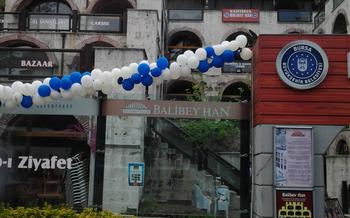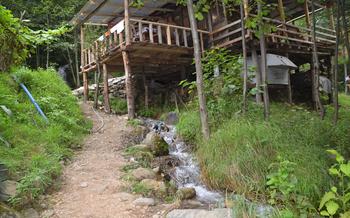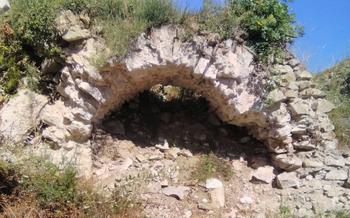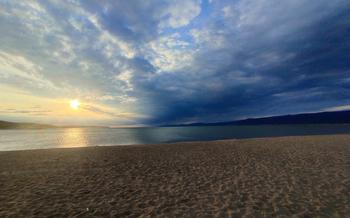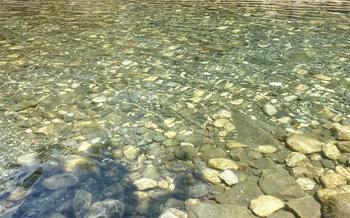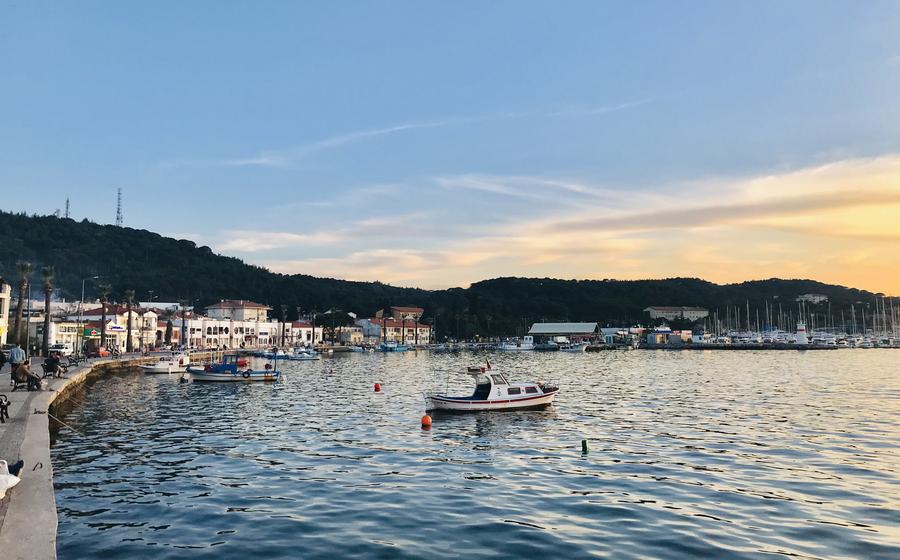
The Stone Bridge on Manyas Lake
- Manyas Lake: A Natural Wonder of Turkey
- The Stone Bridge
- Visiting the Stone Bridge
- The Manyas Bird Sanctuary
- The Water Buffalo of Manyas: Gentle Giants of the Lake
- Boating and Fishing
- Picnicking and Camping
- Cultural and Historical Sites
- Local Delicacies
- The Manyas Mountains: A Haven for Nature Lovers
- Horseback Riding
- Bird Photography
- Kayaking and Canoeing: A Serene Exploration of Manyas Lake
- Visiting the Local Villages
- Insider Tip: The Hidden Cove of Manyas Lake
Manyas Lake: A Natural Wonder of Turkey
Located in the Marmara region of Turkey, Manyas Lake stands as the largest lake in the country, captivating visitors with its serene beauty and ecological significance. Designated as a natural wonder and a protected area, the lake is home to a rich biodiversity that includes over 250 bird species, making it a haven for birdwatchers and nature enthusiasts alike. The unique ecosystem of the lake is further enriched by the presence of water buffalo, adding to its charm and ecological importance.
Manyas Lake is not just a natural wonder but also an important site for environmental education and research. The lake's diverse birdlife, including migratory species like storks, pelicans, and flamingos, offers a valuable opportunity for studying bird behavior and conservation. The presence of the water buffalo, with their unique adaptations to the wetland environment, provides insights into the intricate relationships between species and their habitats.
Whether you are a birdwatcher, a nature lover, or simply seeking a tranquil escape, Manyas Lake offers a wealth of experiences that will leave you mesmerized. From birdwatching and nature photography to environmental education and cultural exploration, this natural wonder has something to offer everyone.
The Stone Bridge
The Stone Bridge, also known as the Manyas Bridge, is an iconic landmark that gracefully spans the Manyas Lake. Its construction dates back to the Ottoman era, with historians attributing it to the reign of Sultan Murad III in the 16th century. The bridge served as a vital connection between the eastern and western shores of the lake, facilitating trade and transportation in the region.
The Stone Bridge is a testament to the engineering prowess of its time. Constructed using large blocks of stone, it features 10 sturdy arches that support its impressive span. The bridge stands as a symbol of strength and resilience, having withstood the test of time and the elements for centuries.
Its strategic location and architectural significance have made the Stone Bridge a focal point of local folklore and legends. Tales of travelers, merchants, and soldiers crossing the bridge have been passed down through generations, adding to the bridge's mystique and cultural allure.
Visiting the Stone Bridge
Reaching the Stone Bridge is a simple and straightforward task. From nearby cities like Balıkesir or Bursa, take the scenic road that leads directly to Manyas Lake. As you approach the lake, follow the signs or ask locals for directions to the Stone Bridge.
The best time to visit the bridge is during the spring or autumn when the weather is pleasant, and the crowds are smaller. Summer months can be hot and crowded, while winters can be chilly and snowy.
Once you arrive at the Stone Bridge, take your time to admire its grandeur and appreciate the stunning views of the lake and the surrounding landscape. Stroll along the bridge, capturing photos, and soaking in the tranquility of the area.
For a more immersive experience, explore the area around the bridge. Follow the scenic walking trails that wind through the lush vegetation and provide opportunities for birdwatching and wildlife encounters. Set up a picnic at one of the designated areas and enjoy a meal surrounded by nature's beauty.
The Manyas Bird Sanctuary
The Manyas Bird Sanctuary, a haven for birdwatchers and nature enthusiasts, is a must-visit destination within the Manyas Lake region. This internationally recognized sanctuary serves as a breeding ground and wintering site for numerous bird species, making it a crucial habitat for avian conservation.
The sanctuary's diverse birdlife includes a remarkable array of migratory birds, such as storks, pelicans, and flamingos, which flock to the lake's shores and wetlands. These majestic creatures create a vibrant spectacle, transforming the tranquil waters into a kaleidoscope of colors and sounds.
Birdwatching enthusiasts can embark on guided tours or explore the sanctuary's designated trails, immersing themselves in the unique ecosystem and observing the birds in their natural habitat. The sanctuary also offers educational programs and workshops, providing visitors with insights into the importance of bird conservation and the sanctuary's ongoing research initiatives.
Whether you're an experienced birdwatcher or simply seeking a tranquil escape surrounded by nature, the Manyas Bird Sanctuary promises an unforgettable experience, allowing you to witness the wonders of the avian world and contribute to the preservation of this remarkable ecosystem.
The Water Buffalo of Manyas: Gentle Giants of the Lake
In the serene landscapes of Manyas Lake, one cannot miss the presence of the majestic water buffalo, an iconic symbol of the region. These gentle giants, with their imposing size and amphibious nature, have become an integral part of the local ecosystem and culture.
Distinguished by their massive frames, water buffalo are well-adapted to the wetlands of Manyas Lake. Their large hooves distribute their weight evenly, allowing them to navigate the marshy terrain with ease. Their broad muzzles and thick lips are perfectly suited for grazing on the lush vegetation that thrives along the lakeshore.
Beyond their physical attributes, water buffalo hold significant cultural and economic importance in the Manyas region. Their milk is highly valued for its rich flavor and nutritional properties, forming the basis of traditional dairy products such as yogurt, cheese, and kaymak. Water buffalo also play a crucial role in agriculture, providing draft power for plowing fields and transporting goods.
The water buffalo of Manyas have become deeply entwined with local traditions and folklore. Festivals and competitions centered around these magnificent animals are held throughout the year, showcasing their strength, agility, and the deep bond they share with the local farmers.
Witnessing these gentle giants grazing peacefully along the shores of Manyas Lake is a truly awe-inspiring experience. Their presence adds a unique charm to the region, highlighting the harmonious coexistence between nature and human culture.
Boating and Fishing
Manyas Lake offers a serene and picturesque setting for boating enthusiasts. Whether you prefer the tranquility of a rowboat or the thrill of a motorboat, there are plenty of options to choose from. Traditional wooden boats, reminiscent of a bygone era, are also available for rent, providing a unique and authentic experience.
For those who enjoy the thrill of the catch, Manyas Lake is a haven for fishing enthusiasts. The lake is home to a diverse array of fish species, including carp, pike, and perch. Whether you're a seasoned angler or a novice looking to try your luck, the lake offers ample opportunities for a successful fishing trip.
Before embarking on your fishing adventure, it's essential to obtain the necessary permits and licenses. Local authorities strictly enforce fishing regulations, and compliance is mandatory. Additionally, consider hiring a local guide who can provide valuable insights into the best fishing spots and techniques.
As you cast your line into the tranquil waters of Manyas Lake, surrounded by stunning natural scenery, you'll experience a sense of serenity and tranquility that is hard to find anywhere else. Whether you're a seasoned angler or a nature lover seeking a unique experience, Manyas Lake promises an unforgettable adventure.
Picnicking and Camping
Manyas Lake offers designated picnic areas, inviting visitors to enjoy a leisurely meal surrounded by nature's tranquility. These areas are equipped with tables, benches, and barbecue grills, providing a convenient and comfortable setting for a picnic.
For a more immersive experience, camping is an excellent option. Several designated camping sites are available around the lake, allowing visitors to camp under the stars and wake up to the serene views of the lake.
When camping at Manyas Lake, it is essential to follow responsible camping practices to minimize environmental impact. Visitors should use designated fire pits for campfires, dispose of waste properly, and respect the natural surroundings.
By embracing the beauty of Manyas Lake through picnicking or camping, visitors can create lasting memories while immersing themselves in the tranquility and natural wonders of this unique destination.
Cultural and Historical Sites
The region surrounding Manyas Lake boasts a rich historical and cultural heritage that visitors can explore alongside its natural wonders. Nearby historical sites and landmarks include ancient ruins, castles, and museums that offer a glimpse into the region's past. Visitors can delve into the history of the Ottoman Empire at the Manyas Castle, a well-preserved fortress that once guarded the region. The town of Manyas itself is steeped in history, with charming Ottoman-era houses and narrow cobblestone streets that transport visitors back in time.
Exploring the cultural heritage of the region reveals local traditions, handicrafts, and cuisine that have been passed down through generations. Visitors can witness traditional crafts such as carpet weaving and pottery making in local workshops and markets. The region's cuisine is a delightful blend of Turkish and local influences, featuring dishes made with fresh ingredients from the lake and surrounding countryside. To fully immerse in the local culture, visitors can attend traditional festivals and events that showcase the region's rich heritage, such as the annual Manyas Bird Festival or the Water Buffalo Festival.
Local Delicacies
The Manyas region boasts a rich culinary heritage influenced by its natural resources and cultural diversity. Visitors can indulge in a variety of must-try local dishes that showcase the flavors of the region.
One of the highlights is the freshly caught fish from Manyas Lake, prepared in a variety of traditional stews and grilled dishes. The lake's unique ecosystem contributes to the distinct flavor and texture of the fish, making it a must-try for seafood enthusiasts.
Another local delicacy is water buffalo yogurt, made from the milk of the region's iconic water buffalo. This creamy and tangy yogurt is a specialty of the Manyas region and is often served with honey or fruit preserves for a delightful breakfast or snack.
For those with a sweet tooth, the region's traditional pastries are not to be missed. Baklava, a flaky filo pastry filled with nuts and sweetened with syrup, is a popular choice, as are künefe, a crispy shredded wheat pastry filled with cheese and drizzled with syrup, and lokum, a soft and chewy Turkish delight made with sugar, starch, and flavorings.
To experience the authentic flavors of Manyas, visitors can head to local restaurants or eateries, many of which offer traditional dishes prepared with fresh, local ingredients. These restaurants often have charming outdoor seating areas, allowing diners to enjoy their meals while taking in the beautiful surroundings of the lake and mountains.
Local food markets are also a great place to sample the region's culinary delights. Visitors can find a variety of fresh produce, artisanal cheeses, and homemade jams and preserves, as well as traditional Turkish sweets and pastries. These markets are a vibrant and colorful affair, offering a glimpse into the daily life of the local community.
The Manyas Mountains: A Haven for Nature Lovers
The Manyas Mountains, a majestic range towering over the serene Manyas Lake, beckon nature enthusiasts with their diverse landscapes and breathtaking vistas. These mountains offer a sanctuary for adventure seekers, inviting them to explore hidden trails, traverse lush forests, and ascend to panoramic viewpoints.
Whether you're an experienced hiker eager for a challenging trek or a casual walker seeking a leisurely stroll, the Manyas Mountains have something to offer. The well-marked trails wind through enchanting forests, where the symphony of birdsong fills the air and the rustling leaves create a soothing rhythm underfoot. As you climb higher, the landscape transforms, revealing meadows carpeted in wildflowers and rocky peaks that pierce the azure sky.
For those seeking a more adrenaline-pumping experience, there are challenging trails that lead to the summits of the highest peaks. The panoramic views from the top are simply breathtaking, offering unparalleled vistas of the shimmering Manyas Lake, the sprawling countryside, and the distant mountain ranges.
The Manyas Mountains are not just a haven for hikers; they are also home to a diverse array of wildlife. Keep an eye out for shy deer grazing in the meadows, agile squirrels darting among the trees, and majestic eagles soaring overhead. With a bit of patience and luck, you might even encounter the elusive wolves that roam the mountain slopes.
Remember to pack your camera to capture the stunning scenery and wildlife encounters. The Manyas Mountains are a photographer's paradise, offering endless opportunities to create breathtaking images that will forever immortalize your adventures.
Horseback Riding
Horseback riding is a popular activity in the Manyas region, offering a unique way to explore the natural surroundings. Scenic trails and countryside routes wind through forests, meadows, and along the shores of Manyas Lake, providing riders with breathtaking views and opportunities to encounter wildlife. Local stables and tour operators offer guided horseback riding excursions, catering to both experienced riders and beginners. Safety measures and riding instructions are provided to ensure a safe and enjoyable experience for all participants. Embark on a horseback adventure and create lasting memories as you explore the picturesque landscapes of the Manyas region on horseback.
Bird Photography
Manyas Lake is a haven for bird photographers, offering a diverse range of bird species and stunning natural scenery. With its rich biodiversity and unique ecosystem, the lake attracts a wide variety of birds, including migratory species like storks, pelicans, and flamingos. The best time for bird photography is early morning or late evening, when the light is soft and the birds are most active. Specific spots around the lake, such as the Manyas Bird Sanctuary and the reed beds along the shoreline, are known for their high concentration of birdlife. To capture stunning bird photographs, it is essential to choose the right camera equipment and techniques. A telephoto lens is crucial for getting close-up shots of birds, while a tripod ensures stability and minimizes camera shake. Patience and observation are also key, as birds can be easily spooked by sudden movements or loud noises. By following these tips and respecting the natural environment, bird photographers can capture breathtaking images that showcase the beauty and diversity of Manyas Lake.
Kayaking and Canoeing: A Serene Exploration of Manyas Lake
Gently paddling across the tranquil waters of Manyas Lake, surrounded by breathtaking natural scenery, offers a unique and serene experience for visitors. Whether you're a seasoned kayaker or a novice paddler, the lake provides an ideal setting for a peaceful and enjoyable excursion.
Various types of kayaks and canoes are available for rent at designated points around the lake, catering to different preferences and skill levels. Embark on a leisurely paddle along the shoreline, immersing yourself in the tranquil beauty of the lake and its surroundings.
Explore hidden coves and inlets, where the water reflects the vibrant colors of the surrounding vegetation. Observe the diverse birdlife that calls the lake home, as they soar overhead or glide gracefully across the water's surface.
For a more adventurous experience, venture further into the lake, where you can witness the stunning panoramic views of the Manyas Mountains and the vast expanse of the lake. Take a break on a secluded island or along the shoreline to enjoy a picnic lunch and soak in the tranquility of the natural surroundings.
Remember to prioritize safety during your kayaking or canoeing excursion. Wear appropriate clothing and life jackets, and be mindful of the weather conditions and your skill level. Local guides or tour operators can provide valuable advice and assistance to ensure a safe and enjoyable experience on the lake.
Visiting the Local Villages
Nestled amidst the picturesque landscapes of Manyas Lake are numerous charming villages that offer a glimpse into the authentic Turkish way of life. Each village boasts unique traditions, handicrafts, and cultural heritage, waiting to be discovered by curious travelers. Stroll through the cobblestone streets, admire the traditional architecture, and visit local markets to interact with the friendly villagers. Learn about their customs, sample their delicious cuisine, and purchase unique souvenirs handcrafted by local artisans. Consider staying in a local guesthouse or homestay to fully immerse yourself in the village experience. These homestays provide a warm and welcoming atmosphere, allowing you to connect with the locals, learn about their daily lives, and create lasting memories.
Insider Tip: The Hidden Cove of Manyas Lake
For those seeking an exclusive and serene experience, Manyas Lake holds a hidden gem waiting to be discovered—the secluded cove of Kadinlar Denizi (Women's Sea). Nestled amidst lush reeds and towering trees, this tranquil haven offers a tranquil retreat away from the bustling crowds. Visitors can bask in the tranquility of the cove, indulge in sunbathing, or take a refreshing dip in the crystal-clear waters. The cove is also a haven for birdwatchers, providing a unique opportunity to observe the diverse avian life that calls the lake home. To reach this hidden paradise, follow the path that leads from the village of Çınarlı to the lake's edge. Remember to tread lightly and respect the fragile ecosystem that makes this spot so special.




